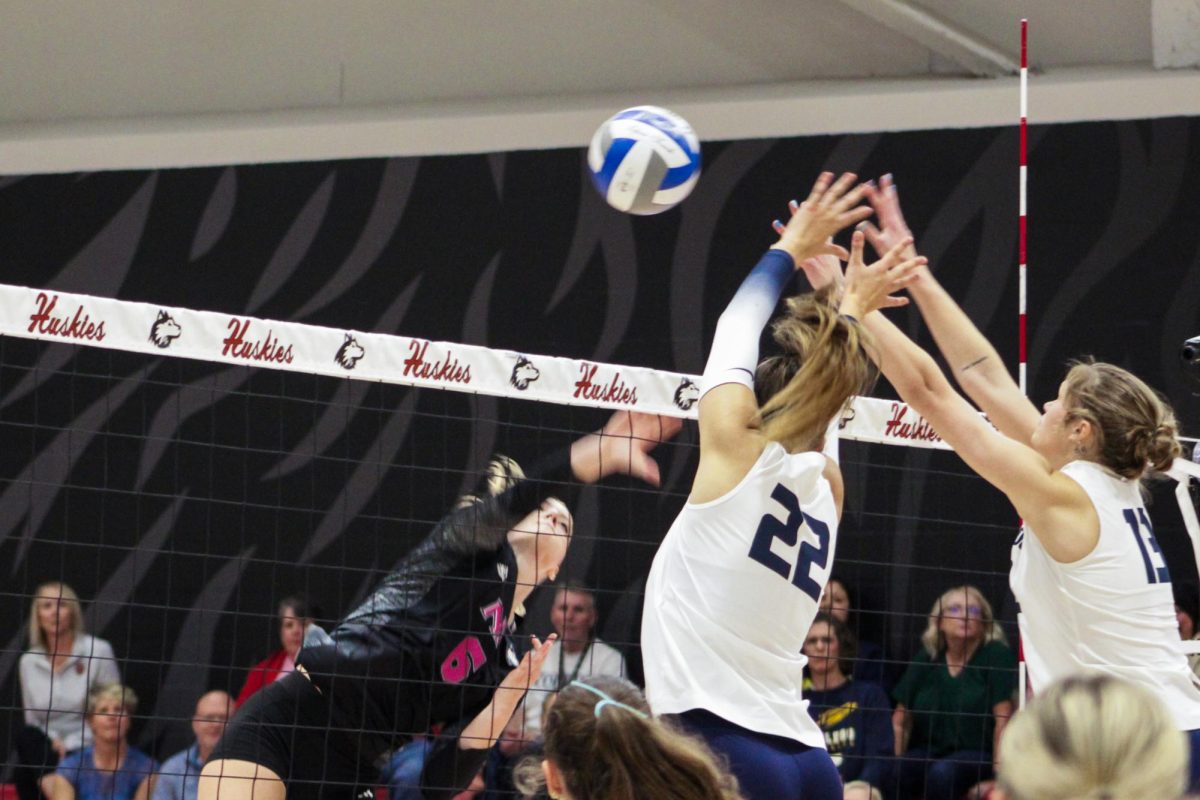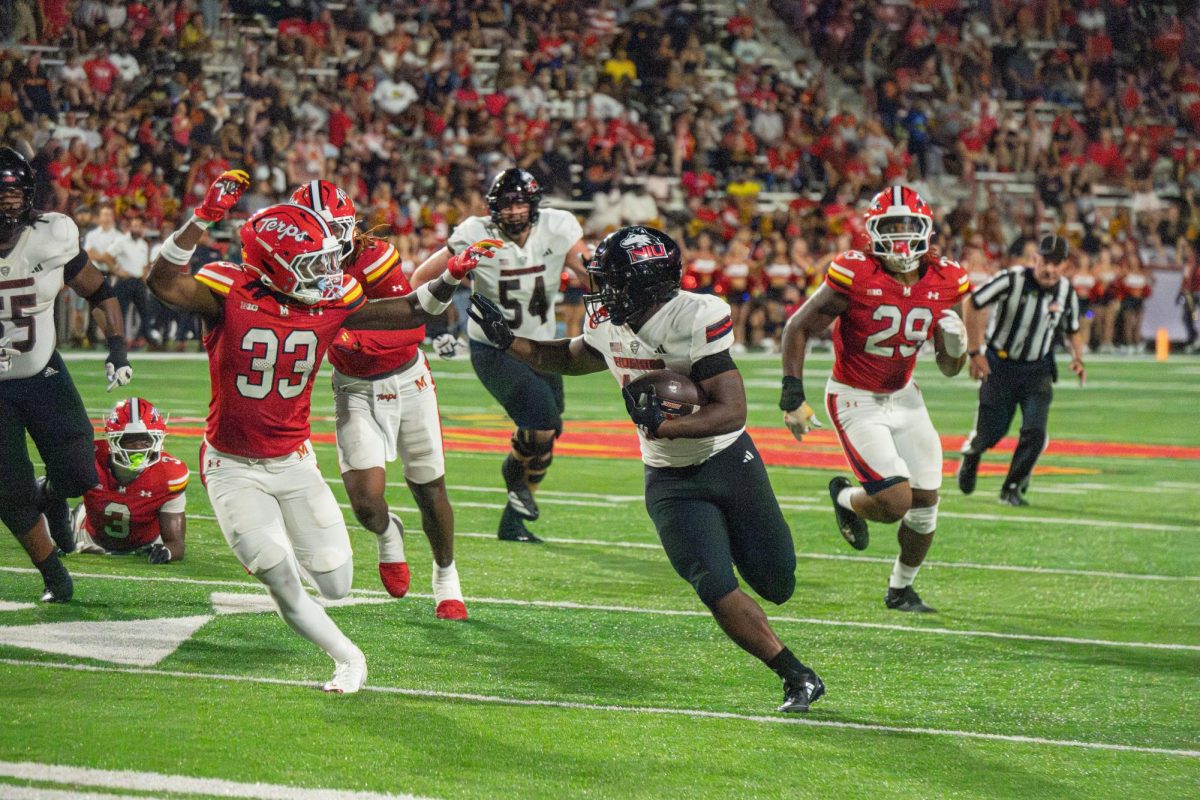We’ve all seen videos of wrestlers shaving their heads and sprinting on treadmills in desperate attempts to shake weight off before weigh-ins. We’ve heard stories of wrestlers endlessly chugging water and eating six meals in a day hoping to gain a few pounds before stepping onto the scale.
Neither side of this spectrum is how the NIU wrestling team goes about weight management. With a team of coaches, strength and conditioning staff and a nutritionist, wrestlers are well-equipped to manage their weight classes throughout the season.
“Wrestling, in my opinion, is the most challenging sport that there is,” NIU wrestling head coach Ryan Ludwig said. “I think the weight control can be the most miserable part of it if you’re not doing it correctly. We really try to encourage our guys to [manage weight correctly].”
Ludwig works closely with his wrestlers to make sure they’re comfortable competing with their assigned weight class throughout the season. He meets with each individual wrestler in the spring and helps them determine which weight class they’ll work in the upcoming season.
“We’ll evaluate how the current year went and then talk about weight classes moving forward,” Ludwig said. “[We see] if a guy continued to grow, what our roster looks like, do we need to go down a weight class or move up a weight class, do we feel comfortable where we’re at, all of those kinds of things, then we get a plan together. We can kind of custom build that moving into spring and summer, and eventually fall, where we do get down, scratch weight and compete.”
In the 1990s, collegiate wrestlers would resort to unsafe methods of weight loss to make weight before a match or tournament. This led to multiple cases of death, causing the NCAA to overhaul the rules. Now, all NCAA teams need to certify through a system to ensure athletes are wrestling at a healthy weight based on body fat percentage and hydration. This prevents wrestlers from gaining or losing weight in harmful ways.
“I think it’s [an] a lot better, more healthy system than what it was 30 years ago,” Ludwig said. “The things that we do to help these guys out is educate them in nutrition. We all, kind of, team up and help advise these guys and educate them on good food to put in, foods to avoid, times to eat [and] proper hydration. If guys need further advice, [they can] have individual consultations and talk about those particular instances. We come up with a plan for each guy based on their individual body and body type, and [get] them feeling good ultimately when they compete.”
Weight classes in wrestling range from 125 to 285 pounds, with eight weight classes in between. Although there’s a lot of room for weight to fluctuate, NIU wrestlers regulate their diets and training regimens with experience and support behind them. Redshirt junior Jacob Christensen is a Huskie heavyweight and maintains a weight above 197 through exercise and a protein and carb-filled diet. He’s heard stories of extreme weight gain and loss and believes they separate experienced wrestlers from unseasoned ones.
“It’s just those people who don’t know how to cut weight,” Christensen said. “They try and save it. For those who are smart about it and manage their food and water, it gets pretty easy. It’s just discipline really, and I think that’s what a lot of people lack. Especially in this sport, [people] don’t have the discipline to say no to certain foods or certain beverages that aren’t going to help you lose the weight or perform well.”
As a heavyweight, Christensen doesn’t have as many diet or water restrictions as other weight classes do. He’s able to maintain his weight without cutting it out of necessity. He counts calories and focuses on proteins and carbs like the other weight classes but lifts heavier weights and eats more to keep up muscle mass.
“The thing with heavyweight, I will say, is it’s such a broad weight class,” he explained. “If you’re 198 [pounds], you’re wrestling guys who could be 285 [pounds]. [The weight class] is so big, that if you’re not keeping up with your weight and your strength, you’re going to get dominated. Not having the food restriction and water restriction is very, very nice.”
While heavyweights don’t spend as much time worrying about diet restrictions, lighter weights need to pay more attention to calories and how much weight they lift. Senior Lucian Brink in the 133-pound class is well-versed in maintaining lighter weights having also wrestled in the 125 weight class.
“We don’t do as much lifting; we have less sets and less weight,” Brink said. “For food, we’re fueling up a lot during the beginning of the week then we kind of taper it off. Everyone kind of does it differently. I like to stay hydrated until the end of the week, and then start to suck everything down and feel as good as I can.”
While these two wrestlers require slightly different training and diet practices, their commitment remains the same. Neither has missed a weigh-in at NIU, and they both attribute it to experience and discipline. Wrestlers have to weigh in one or two hours before any competition to record their scratch weight. They must either weigh in at their weight class or below, otherwise they can’t compete. The Huskies have a lot of control over which weight class they compete in, and Ludwig emphasized that it’s rare for his team to not make weight.
“If they don’t make that, it’s a tough conversation, because now you’ve kind of let the team down,” Ludwig explained. “You’re not able to compete. If that does happen, then maybe the conversation would be ‘How did we cut our weight?’ Did we do it the wrong way which is not eating all week, which is getting too dehydrated too soon, those kinds of things. Are we cutting too much weight? Is the weight class too low? Are you growing? Do we need to move up? All of those conversations can be had at that point.”
Brink knows what it looks like when wrestlers try to cut weight at the last minute, and it fits the drama people envision when thinking about wrestling weight loss. He reflected on the dangerous behavior and boiled it down to a lack of self-control.
“We had a guy my freshman year; he was kind of terrible at cutting weight,” Brink said. “He would save everything. Usually, it’s the guys that struggle are the guys who save it all until the end of the week. They’re eating whatever they want. They’re 10 to 20 pounds over, and they end up trying to [lose] it all the night before. At a certain point in the night, they just give up and crash. Even if they were to make the weight, you’re not going to have the energy, because you’ve been working out for 10 hours straight trying to get it off. That’s just not the way to do it.”
Brink emphasized that last-minute weight changes are not the standard practice among wrestlers.
“A lot of people assume that those guys who don’t know how to cut weight are all of us,” Brink continued. “Like we all wait until the day before. You hear the stories of ‘I lost 20 pounds in an hour.’ You don’t get that at this level. You can’t. You’re not going to have the energy to compete, so you have to do it right.”
Ludwig affirmed making sure his wrestlers eat properly throughout the season is a top priority for NIU wrestling.
“At the lighter weights through the upper weights, we want our guys to eat all week,” Ludwig said. “We make sure that they do that. We really lecture them about that. Every guy has individual ways that he does things, and some guys need more consultation than others, but I think the general principles remain the same up and down the lineup, regardless of whether you’re cutting a lot of weight or not.”




















